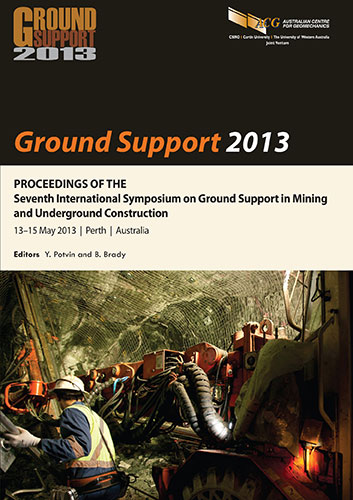Ground support design under highly stressed conditions

|
Authors: Vakili, A; Sandy, MP; Mathews, M; Rodda, B |
DOI https://doi.org/10.36487/ACG_rep/1304_38_Vakili
Cite As:
Vakili, A, Sandy, MP, Mathews, M & Rodda, B 2013, 'Ground support design under highly stressed conditions', in Y Potvin & B Brady (eds), Ground Support 2013: Proceedings of the Seventh International Symposium on Ground Support in Mining and Underground Construction, Australian Centre for Geomechanics, Perth, pp. 551-564, https://doi.org/10.36487/ACG_rep/1304_38_Vakili
Abstract:
Development advance rates in mining projects have been increasing substantially in recent years and the number of mines operating at greater depth in Australia and other countries is increasing. In general, this requires more systematic ground support design in more severe ground conditions such as those that exist in highly stressed and highly anisotropic rock masses. In particular, more attention is required in relation to the timing of ground support installation and the interaction between the ground support and the rock mass. This paper describes a numerical modelling method that can be used as a tool to optimise the ground support design in more severe ground conditions. A new quantitative guideline is presented, summarising the typical response of ‘massive’, ‘moderately jointed’ and ‘highly jointed’ rock masses to increasing stress levels. A case study is also presented, in which advanced modelling techniques were used to improve the ground support performance through optimisation of timing and stiffness of the ground support system at the CSA mine in Cobar, New South Wales. The ground displacement and closure strain were carefully monitored at CSA, and a comprehensive development and stope damage database was compiled. The numerical model was then accurately calibrated using the instrumentation data and the damage history of the mine.
References:
Aydan, O., Akagi, T. and Kawamoto, T. (1993) The squeezing potential of rock around tunnels: theory and prediction, Rock Mechanics and Rock Engineering, Vol. 2, pp. 137–163.
Barton, N. (1974) A review of the shear strength of filled discontinuities in rock, Norwegian Geotechnical Institute Publication, No. 105, Norwegian Geotechnical Institute, Oslo.
Hajiabdolmajid, V., Kaiser, P.K. and Martin, C.D. (2002) Modelling brittle failure of rock, International Journal of Rock Mechanics and Mining Sciences, Vol. 39(6), pp. 731–741.
Hoek, E. (2001) Big tunnels in bad rock, ASCE Journal of Geotechnical and Geoenvironmental Engineering, Vol. 127, No. 9, September 2001, pp. 726–740.
Hosken, J. Haren, E. and Winchester, A. (2006) Resource Modelling in an Evolving Mine — CSA Mine, Cobar, New South Wales, in Proceedings Sixth International Mining Geology Conference, 21–23 August 2006, Darwin, Australia, The Australasian Institue of Mining and Metallurgy, Carlton.
Kazerani, T. and Zhao, J. (2010) Micromechanical parameters in bonded particle method for modelling of brittle material failure, International Journal of Numerical and Analytical Methods in Geomechanics, Vol. 12, pp. 12–13.
Maerz, N.H. and Germain, P. (1996) Block size determination around underground openings using simulations, in Proceedings FRAGBLAST 5 Workshop on Measurement of Blast Fragmentation, J.A. Franklin and T. Katsabanis (eds), 23–24 August 1996, Montreal, Canada, pp. 215–223.
Martin, C.D., Kaiser, P.K. and McCreath, D.R. (1999) Hoek-Brown parameters for predicting the depth of brittle failure around tunnels, Canadian Geotechnical Journal, Vol. 36(1), pp. 136–151.
Potvin, Y. and Hadjigeorgiou, J. (2008) Ground support strategies to control large deformations in mining excavations, Journal of the Southern African Institute of Mining and Metallurgy, Vol. 108(7), pp. 397–404.
Read, R.S. (1994) Interpreting excavation-induced displacements around a tunnel in highly stressed granite, Ph.D. thesis, Department of Civil and Geological Engineering, University of Manitoba, Canada, 328 p.
Sakurai, S. (1997) Lessons learned from field measurements in tunnelling, Tunnelling and Underground Space Technology, Vol. 12(4), pp. 453–460.
Sandy, M., Sharrock, G., Albrecht, J. and Vakili, A. (2010) Managing the Transition from Low-stress to High-stress Conditions, in Proceedings Second Australasian Ground Control in Mining Conference, 23–24 November 2010, Sydney, Australia, The Australasian Institute of Mining and Metallurgy, Carlton.
Singh, B., Jethwa, J.L., Dube, A.K. and Singh, B. (1992) Correlation between observed support pressure and rock mass quality, Tunnelling and Underground Space Technology, Vol. 7, pp. 59–74.
Singh, M., Singh, B. and Choudhari, J. (2007) Critical strain and squeezing of rock mass in tunnels, Tunnelling and Underground Space Technology, Vol. 22, pp. 343–350.
Vakili, A. Sandy, M. and Albrecht, J. (2012) Interpretation of Non-linear Numerical Models in Geomechanics – a Case Study in the Application of Numerical Modelling for Raise Bored Shaft Design in a Highly Stressed and Foliated Rockmass, in Proceedings Sixth International Conference and Exhibition on Mass Mining (MassMin 2012), 10–14 June 2012, Sudbury, Canada.
© Copyright 2025, Australian Centre for Geomechanics (ACG), The University of Western Australia. All rights reserved.
View copyright/legal information
Please direct any queries or error reports to repository-acg@uwa.edu.au
View copyright/legal information
Please direct any queries or error reports to repository-acg@uwa.edu.au